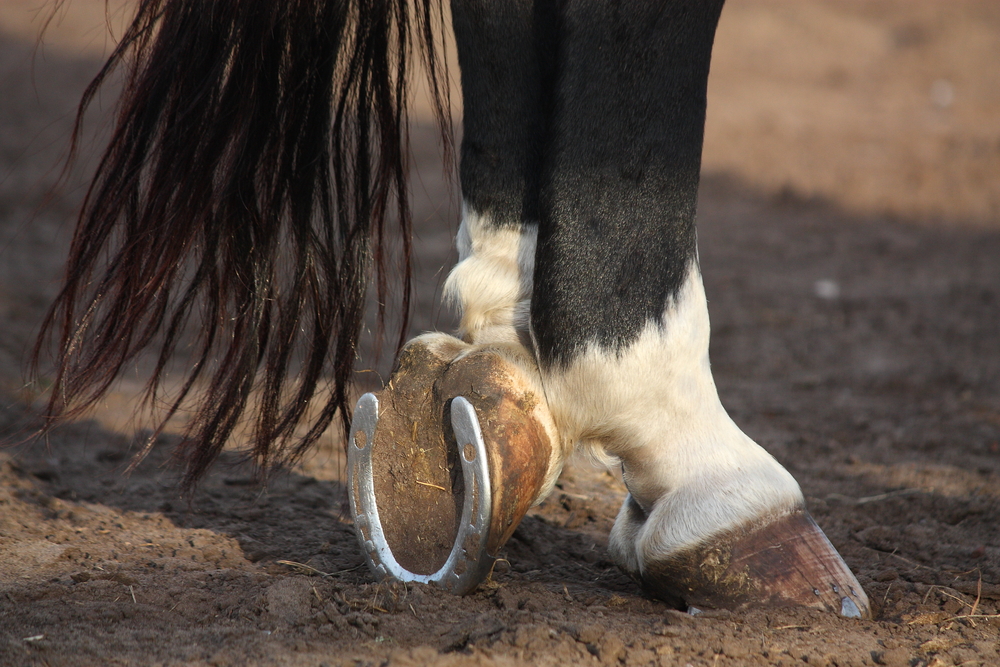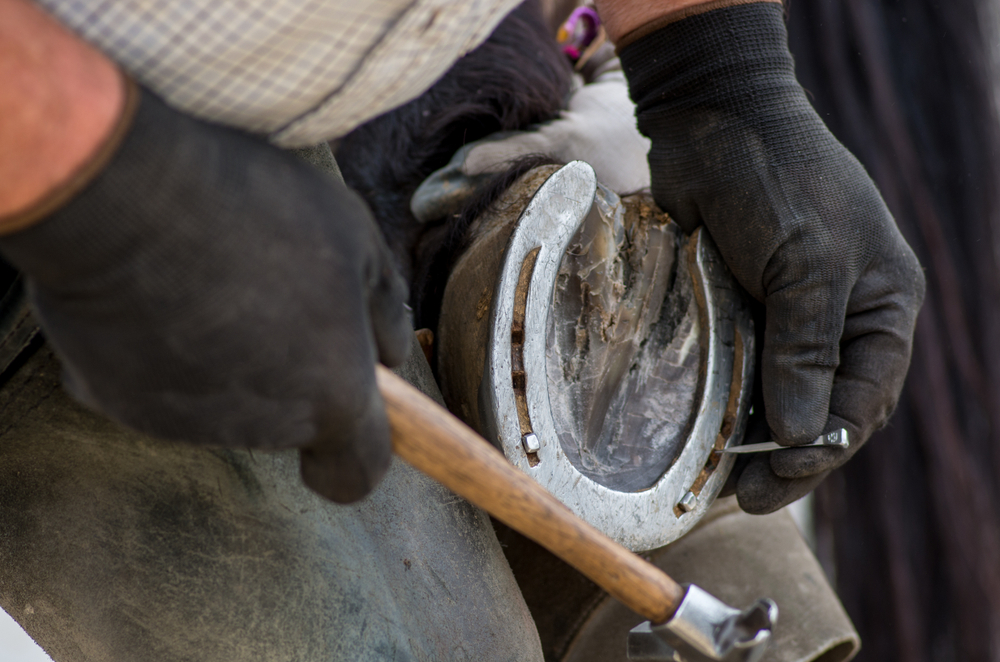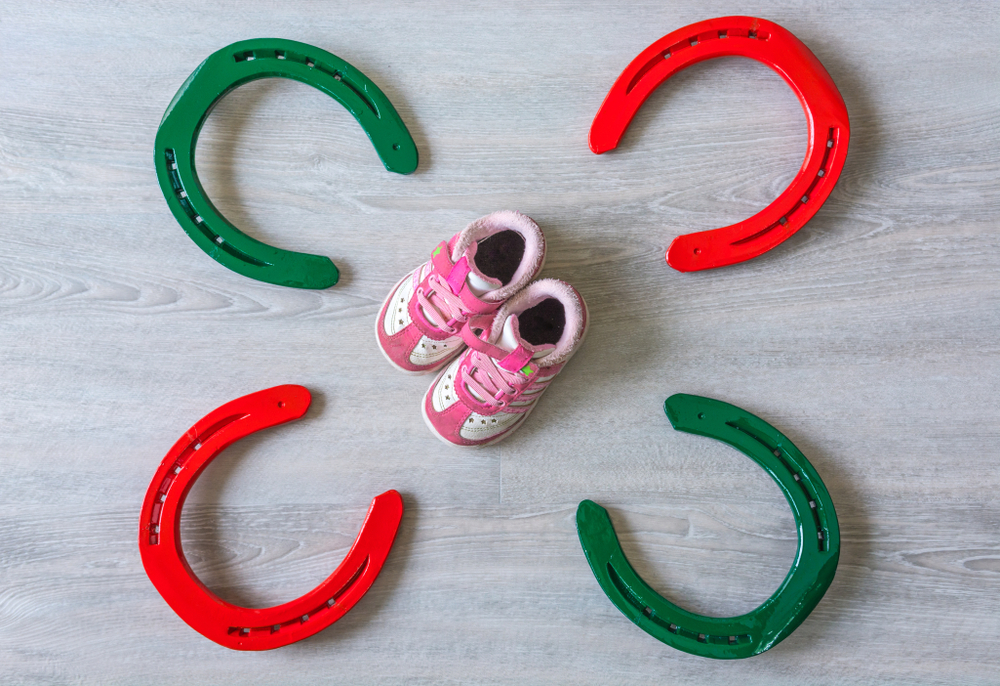- Your source for stall mats, rubber arena footing, arena harrows and arena dust control.

Horseshoes make horses sound louder as they walk. They make it all the more painful when a horse steps on your foot. Horseshoes are hung on doorways for luck. The symbol has been turned into necklaces and even stuck on marshmallows in cereal. But why do horses need shoes?
Horses need shoes to protect their hooves and to provide traction. Surfaces such as cobblestones and concrete can damage horses’ hooves. Also, just as some human nails are stronger than others, some horses have a softer hoof and benefit from the extra protection provided by horseshoes.
But not all horses wear horseshoes. How do you know if your horse needs them ? Why do horses go through them so quickly? What’s the difference between those that are nailed on and those that are glued? Are hoof boots the same as horseshoes? The world of horseshoes is vast and complicated.
? Why do horses go through them so quickly? What’s the difference between those that are nailed on and those that are glued? Are hoof boots the same as horseshoes? The world of horseshoes is vast and complicated.
Horseshoes: The Basics
The most common Horseshoes are constructed of steel or aluminum. However, there are even horseshoes made of plastic. Horseshoes are put on a horse by a farrier and are usually secured by nails. Horseshoes will need to be changed every four to eight weeks because like human nails, hooves keep growing too.
After the farrier removes the old shoes, the hoof will be trimmed and shaped, much like humans attending to their fingernails, before the next shoes are put on. The nails the farrier uses are specifically made for the purpose and often have coatings to prevent or destroy certain bacteria and other microbes.
Horseshoes can help protect a hoof and provide traction, including using studs for icy conditions. Horseshoes can also be helpful for certain managing certain conditions: aid with hoof balance used to redistribute pressure on the hoof after an injury, and correct hoof abnormalities.
What are Farriers?
As mentioned above, a farrier is a person who knows how to trim and shape horse hooves and correctly fit horseshoes. They also look at the hooves’ overall health, often the first to spot a budding problem.
This is a specialist position that also requires a great deal of physical strength. British Farriers are required to go through a four-year apprenticeship and then be registered through the Farriers’ Registration Council. The United States does not require official licensing or registration, although it is encouraged, and there are those that want this changed.
are required to go through a four-year apprenticeship and then be registered through the Farriers’ Registration Council. The United States does not require official licensing or registration, although it is encouraged, and there are those that want this changed.
There is a wide range in farrier income, and different surveys report different figures
and different surveys report different figures . Those working in the horseracing industry can make up to 200,000 dollars. However, in some parts of the United States, some farriers make as little as $18,749.
. Those working in the horseracing industry can make up to 200,000 dollars. However, in some parts of the United States, some farriers make as little as $18,749.
Government regulations in the UK help keep the bottom salary of farriers higher. However, apprentice salary is about half the rate of the bottom tiers of qualified farriers.
History of Horseshoes
The practice of nailing on horseshoes emerged during the Middle Ages in Europe . These shoes started off in bronze and progressed as new metals became available.
. These shoes started off in bronze and progressed as new metals became available.
However, caring for a domestic horse’s hooves is an ancient practice. The Ancient Greeks, for example, used layers of pebbles to help ensure an even wear of the hoof.
Roman Legions began making a type of hoof boot called “hippo sandals” around 400 AD. Like hoof boots, these came on and off and did not require nails. They were typically made from rawhide, leather scraps, or plants.
Horse riders in ancient Asia also came up with something similar to the Roman Legions. These horseshoes were generally made of woven plants and not only provided protection but were for medicinal purposes .
.
In the past, farriers were a type of blacksmith that made horseshoes in addition to tending to horse hooves. Nowadays horseshoes are often prefabricated, although many farriers still have the skills to make adjustments or provide custom-made if needed.
Are Horseshoes Painful for Horses?
Technically, horseshoes don’t hurt a horse. The outer hoof, the part you see, is made of keratin, the same protein that makes nails, hair, and even horns (not antlers, those are made from bone). Thus, when a horseshoe is put on correctly, the horse feels no pain.
However, things can go wrong, just like they can when a person gets a pedicure. A nail in the wrong place can cause a horse pain and, at times, lead to an abscess. Some horses are also infamous for losing their shoes. Sometimes it is no big deal (aside from the cost). But sometimes, the way the horseshoe was pulled off can injure the hoof and possibly tendons.
Also, just as humans can have sore feet from wearing poor shoes or the wrong fit, so can horses. This is why a qualified farrier should only shoe a horse. Of course, not all farriers are equal, so it is important to research before handing your horse’s hooves over to another person.

Horseshoes: Glue-on, Tape-on, or Hoof Boots?
Typically, Horseshoes are nailed on or use studs. However, there are other options.
Glue-on Horseshoes
Glue-on horseshoes do not need nails to stay on. They are removed by sliding a utility knife (carefully) between the hoof and shoe. Glue-on horseshoes do tend to cost more than typical horseshoes, however. But you can switch over to glue-on shoes temporarily before returning to standard horseshoes.
horseshoes do not need nails to stay on. They are removed by sliding a utility knife (carefully) between the hoof and shoe. Glue-on horseshoes do tend to cost more than typical horseshoes, however. But you can switch over to glue-on shoes temporarily before returning to standard horseshoes.
Glue-on shoes appeal to people with horses with hoof problems where putting a nail in would be hard, impossible, or amplify the problem.
where putting a nail in would be hard, impossible, or amplify the problem.
They are also a nice option for horses that, for whatever reason, don’t do well with nails or are infamous for losing shoes. Because of how a glue-on shoe separates from the hoof when caught on something, there is little chance of damaging the hoof wall.
Lastly, some horses are barefoot in their everyday life, but due to travel or a special event may require temporary shoes. Again, because there are no nails, the glue-on shoes won’t penetrate the hoof. The lack of nail holes makes transitioning back to barefoot easier for the horse.
Tape-on Horseshoes
Tape-on horseshoes are more of a horse owner making do in a temporary situation, say 24-48 hours. Some just use duct tape. Others use hoof tape, vet wrap, or athletic tape.
are more of a horse owner making do in a temporary situation, say 24-48 hours. Some just use duct tape. Others use hoof tape, vet wrap, or athletic tape.
This blogger uses Mueller Athletic Tape a nd Glove Glue-One shells or boots with additional tape.
nd Glove Glue-One shells or boots with additional tape.
Showjumpers and some other equestrian athletes will also tape their horse’s shoes to secure the overreach bands. An adhesive fabric tape is recommended for this.
An adhesive fabric tape is recommended for this.
Hoof Boots
Hoof Boots are a boot for a horse. They kind of look like giant baby shoes and are secured by a Velcro-type fastening. Some are used for trail riding; other owners use them when the horses are turned out and make havoc with their friends.
are a boot for a horse. They kind of look like giant baby shoes and are secured by a Velcro-type fastening. Some are used for trail riding; other owners use them when the horses are turned out and make havoc with their friends.
Hoof Boots generally can’t be worn in affiliated competitions , such as show jumping. Some unaffiliated competitions are allowing them, however. Endurance riders sometimes have them on hand in case something happens to one of their horse’s shoes. Riders sometimes find hoof boots useful for protecting a horse during transport and in between competitive events.
, such as show jumping. Some unaffiliated competitions are allowing them, however. Endurance riders sometimes have them on hand in case something happens to one of their horse’s shoes. Riders sometimes find hoof boots useful for protecting a horse during transport and in between competitive events.
Barefoot Horse Riding
Not all horses wear shoes. This is often referred to as barefoot riding (that’s the horse, not the rider). It is relatively common in South Africa, for example, for non-race horses to be barefoot.
There are many reasons to avoid horseshoes. For starters, it is cheaper. A horse will still require a farrier to tend to its feet about every six weeks for trimming and shaping. But the horse owner will pay the farrier for less time and doesn’t have to shell out for the shoes.
Also, some horses really don’t need them. Dressage horses, for example, tend to be ridden in groomed arenas, devoid of hard or rough surfaces.
Some riders have found added benefits to riding barefoot. FEI dressage rider Shannon Peters is a big fan of barefoot riding . Her interest in barefoot riding began with her Grand Prix horse, Flor de Selva. The horse had been plagued with problems for the past two years. As a last resort, she tried Flor de Selva barefoot.
. Her interest in barefoot riding began with her Grand Prix horse, Flor de Selva. The horse had been plagued with problems for the past two years. As a last resort, she tried Flor de Selva barefoot.
It was such a success she went on to try it with her husband’s horse Ravel when he cracked his hoof only months before the Olympics. Now she has transitioned 15 horses to barefoot. She firmly believes the horses are healthier and have fewer injuries this way. She will use hoof boots in certain situations, however.
Many horse owners and trainers decide whether to use horseshoes or go barefoot, depending on the horse. However, there are some who believe horseshoes are cruel and should never be used. They feel horseshoes are unnatural a negatively impact a hoof’s natural flexibility and shock absorption. They believe this creates problems not only for the hoof but for the rest of the horse.
Why Don’t Wild Horses Need Shoes or a Farrier?
Wild horses don’t see a farrier. Given even barefoot horses need regular attention to their hooves, it is natural to wonder how these wild horses cope.
Wild horses don’t need shoes due to how much they move. The average wild horse will travel between 20 to 30 miles (30.2 – 48.3 km) a day. This creates natural wear on their hooves, negating the need for regular trimming. Also, they don’t tend to roam on surfaces such as concrete.
This isn’t to say that if you treat your horses like wild ones, roaming large distances, their hooves will be fine. Firstly, domesticated horses are bred for many reasons, and in the quest to achieve certain features, strong hooves were not a chief consideration. A lot of domesticated horses have thinner hooves that would crack and become brittle in the wild.
Also, not everything in nature is kind and lovely. Survival of the fittest plays a significant role in wild horse herds. An injured horse can lead to a horse being left behind. Also, a horse with poor hooves is easier prey for predators. Thus, nature’s own harsh breeding program of natural selection results in wild horses suited to life without a farrier.

17 Ways to Use Old Horseshoes
Horseshoes pile up fast, given they are changed every four to eight weeks. Not everyone lives in an area with a horseshoe recycling program or has access to scrap yards that want aluminum and steel. Here are 17 ways you can make use of those old horseshoes.
- Make friends and family a Horseshoes Game Kit and give them as holiday and birthday gifts. You can make up your own instruction cards to go in the kits by using this site
 . You can find additional advice on building your own horseshoe pit here
. You can find additional advice on building your own horseshoe pit here .
. - Embrace your artistic side and make sculptures from your own horseshoes. Need inspiration? Here are 42 ideas from Pinterest
 .
. - Make key holders from old horseshoes. Stumped on how? This YouTube video will walk you through it
 .
. - Construct your own horseshoe wine rack. There are many design ideas on the internet, but this one comes with instructions.

- Create a boot rack from horseshoes. Searching for ideas? This YouTube will show you how one version can be made
 .
. - For those wanting a project that involves no welding, you can make horseshoe coasters. See this YouTube video on how
 .
. - Horseshoes can make a great gate latch or make a wonderful decorative sliding bolt handle for your stable door. Watch this YouTube video for the gate latch
 and this one for the sliding bolt
and this one for the sliding bolt .
. - A horseshoe Christmas tree will add that special equestrian touch. Here is a YouTube video
 showing how one style was made.
showing how one style was made. - Smarten up your tack room by using horseshoes to create a bridle rack. If you can’t think up your own design, here are DIY instructions
 .
. - Horseshoes can be turned into panel holders to add a unique touch to a room. This blogger walks you through it
 .
. - A wreath can be made of horseshoes. In some versions, you only need to change the ribbons in order to use them for multiple holidays. Or simply make one for year-round decoration. This YouTube video will show you how
 .
. - A towel rack can be constructed from an old pallet and horseshoes. Click here for instructions.

- Horseshoes can make a variety of candle holders. Here are seventeen ideas
 .
. - Toilet roll holders can also be made out of horseshoes. See ideas here
 .
. - A great way to preserve equestrian memories is by putting photos in horseshoe picture frames. This YouTube video will show you how
 .
. - You can do horseshoe craft projects with the kids. Here is a YouTube video with ideas
 .
. - Bookends can be made from horseshoes. You can nail them into blocks of wood or get out a welding torch to try this idea
 .
.
Conclusion
Horseshoes are not going away any time soon, despite barefoot riding becoming increasingly popular. However, horseshoe options are expanding, including the vast array of hoof boots. The important thing, above all else, is to respect what is best for your horse.
Sources
https://www.animalfriends.co.uk/blog/why-do-horses-need-shoes/
https://www.livescience.com/33116-lucky-horseshoes.html
https://thetilth.com/why-do-wild-horses-not-need-shoes/
https://www.thesprucepets.com/shoeing-faq-is-barefoot-better-1885965
https://practicalhorsemanmag.com/health-archive/to-shoe-or-not-to-shoe

